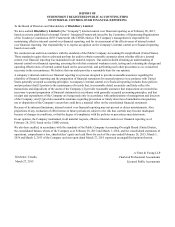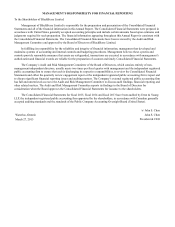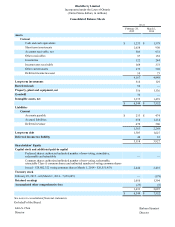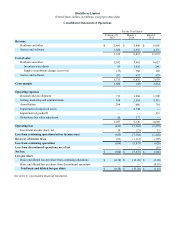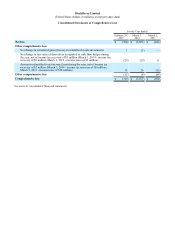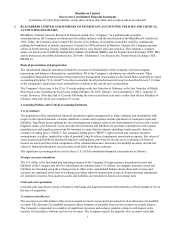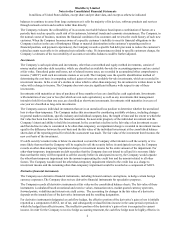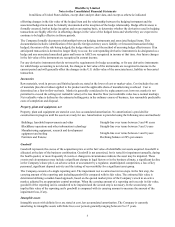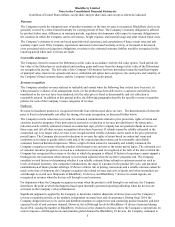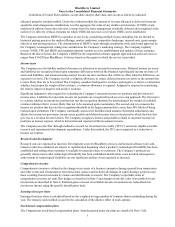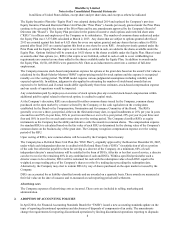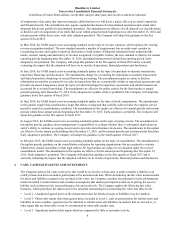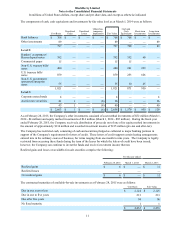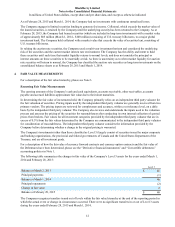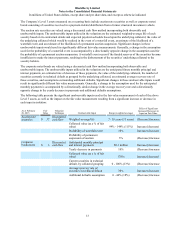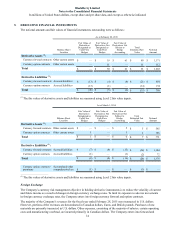Blackberry 2015 Annual Report Download - page 79
Download and view the complete annual report
Please find page 79 of the 2015 Blackberry annual report below. You can navigate through the pages in the report by either clicking on the pages listed below, or by using the keyword search tool below to find specific information within the annual report.BlackBerry Limited
Notes to the Consolidated Financial Statements
In millions of United States dollars, except share and per share data, and except as otherwise indicated
4
The useful lives of intangible assets are evaluated quarterly to determine if events or circumstances warrant a revision to
their remaining period of amortization. Legal, regulatory and contractual factors, the effects of obsolescence, demand,
competition and other economic factors are potential indicators that the useful life of an intangible asset may be revised.
Impairment of long-lived assets
The Company reviews long-lived assets (“LLA”) such as property, plant and equipment and intangible assets with finite
useful lives for impairment whenever events or changes in circumstances indicate that the carrying amount of the asset or
asset group may not be recoverable. These events and circumstances may include significant decreases in the market price
of an asset or asset group, significant changes in the extent or manner in which an asset or asset group is being used by the
Company or in its physical condition, a significant change in legal factors or in the business climate, a history or forecast
of future operating or cash flow losses, significant disposal activity, a significant decline in the Company's share price, a
significant decline in revenues or adverse changes in the economic environment.
When indicators of impairment exist, LLA impairment is tested using a two-step process. The Company performs a cash
flow recoverability test as the first step, which involves comparing the Company's estimated undiscounted future cash
flows to the carrying amount of its net assets, since the Company consists of one asset group. If the net cash flows of the
Company exceed the carrying amount of its net assets, LLA are not considered to be impaired. If the carrying amount
exceeds the net cash flows, there is an indication of potential impairment and the second step of the LLA impairment test
is performed to measure the impairment amount. The second step involves determining the fair value of the asset group,
the Company. Fair value should be determined using valuation techniques that are in accordance with U.S. GAAP,
including the market approach, income approach and cost approach. If the carrying amount of the Company's net assets
exceeds the fair value of the Company, then the excess represents the maximum amount of potential impairment that will
be allocated to the Company's assets on a relative basis, with the limitation that the carrying value of each asset cannot be
reduced to a value lower than its fair value. The total impairment amount allocated is recognized as a non-cash
impairment loss.
Business acquisitions
The Company accounts for its acquisitions using the acquisition method whereby identifiable assets acquired and
liabilities assumed are measured at their fair values as of the date of acquisition. The excess of the acquisition price over
such fair value, if any, is recorded as goodwill, which is not expected to be deductible for tax purposes. The Company
includes the operating results of each acquired business in the consolidated financial statements from the date of
acquisition.
Assets held for sale and discontinued operations
When certain criteria are met, the Company reclassifies assets and related liabilities as held for sale at the lower of their
carrying value or fair value less costs to sell and, if material, presents them separately on the Company’s consolidated
balance sheets. If the carrying value exceeds the fair value less costs to sell, a loss is recognized. If the plan to sell an asset
includes a leaseback arrangement for which the Company will retain more than a minor portion of the use of the asset,
then the asset is not reclassifed as held for sale as all criteria are deemed not to have been met. Assets classified as held
for sale are no longer amortized. Comparative figures are reclassified to conform to the current year’s presentation.
When the Company has disposed of or classified as held for sale a component of the entity, and certain criteria are met,
the results of operations of the component, including any loss recognized, are reported separately on the consolidated
statements of operations as discontinued operations. Discontinued operations are presented if the component’s operations
and cash flows have been, or will be, eliminated from the Company and the Company will not have significant continuing
involvement in the operations of the component after the disposal. Earnings (loss) per share amounts for both continuing
operations and discontinued operations are presented separately on the consolidated statements of operations and income
(loss) from continuing operations and loss from discontinued operations are reported separately on the consolidated
statements of cash flows. Comparative figures are reclassified to conform to the current year’s presentation.
Royalties
The Company recognizes its liability for royalties in accordance with the terms of existing license agreements. Where
license agreements are not yet finalized, the Company recognizes its current estimates of the obligation in accrued
liabilities in the consolidated financial statements. When the license agreements are subsequently finalized, the estimate is
revised accordingly. Management’s estimates of royalty rates are based on the Company’s historical licensing activities,
royalty payment experience, and forward-looking expectations.


